Regal Rexnord Bundle
Who Buys from Regal Rexnord?
Uncover the vital details of Regal Rexnord SWOT Analysis to understand its customer base. Understanding customer demographics and pinpointing the Regal Rexnord target market is crucial for any company's success. This exploration dives deep into the industries and customer profiles that drive Regal Rexnord's business.
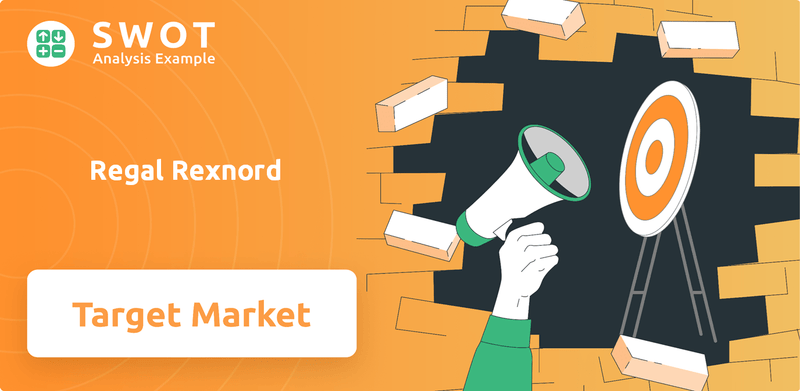
The strategic shift, including the divestiture of its Industrial Systems business, has reshaped the company's focus, making a deep dive into its Regal Rexnord customer profile even more critical. This analysis will examine the company's market segmentation, helping to understand its evolving target audience and how Regal Rexnord adapts to meet the needs of its customers. This includes exploring questions like "What are the demographics of Regal Rexnord's customers?" and "How does Regal Rexnord define its target market?"
Who Are Regal Rexnord’s Main Customers?
Understanding the Regal Rexnord customer profile is key to grasping its market position. The company primarily focuses on business-to-business (B2B) relationships. This means its primary customer segments are industrial enterprises, not individual consumers.
The Regal Rexnord target market spans a wide range of industries. These include factory automation, food and beverage, aerospace, medical, data centers, warehouses, alternative energy, residential and commercial buildings, general industrial, construction, metals and mining, and agriculture. This broad reach highlights the company's diverse customer base.
The company operates through three main segments: Industrial Powertrain Solutions (IPS), Power Efficiency Solutions (PES), and Automation & Motion Control (AMC). These segments each serve different aspects of the industrial market, reflecting a strategic approach to market segmentation.
In 2024, IPS was the largest segment, contributing 43.06% of total revenue. PES followed with 27.25%, and AMC accounted for 27.08%. These figures show the relative importance of each segment in the company's financial performance.
In Q4 2024, IPS saw a 2.3% decrease in net sales, while AMC experienced a 2.6% decrease. PES showed a slight decrease of 0.4%. These figures indicate varying levels of performance across different sectors.
In Q1 2025, PES led with 8.0% organic growth, driven by strong demand in North American residential HVAC markets. AMC showed stability with 0.4% organic growth. IPS experienced a 3.4% organic decrease, but its adjusted EBITDA margin was 26.9%.
The company has strategically shifted its focus. The portfolio is now weighted 75% towards industrial power transmission and automation. This shift follows the divestiture of its Industrial Systems business in April 2024.
The primary customer segments include various industrial sectors. These sectors are critical for understanding the Regal Rexnord customer base breakdown. The company's focus is on sectors with growth potential.
- Factory automation
- Food & beverage
- Aerospace
- Medical
- Data centers
Regal Rexnord SWOT Analysis
- Complete SWOT Breakdown
- Fully Customizable
- Editable in Excel & Word
- Professional Formatting
- Investor-Ready Format
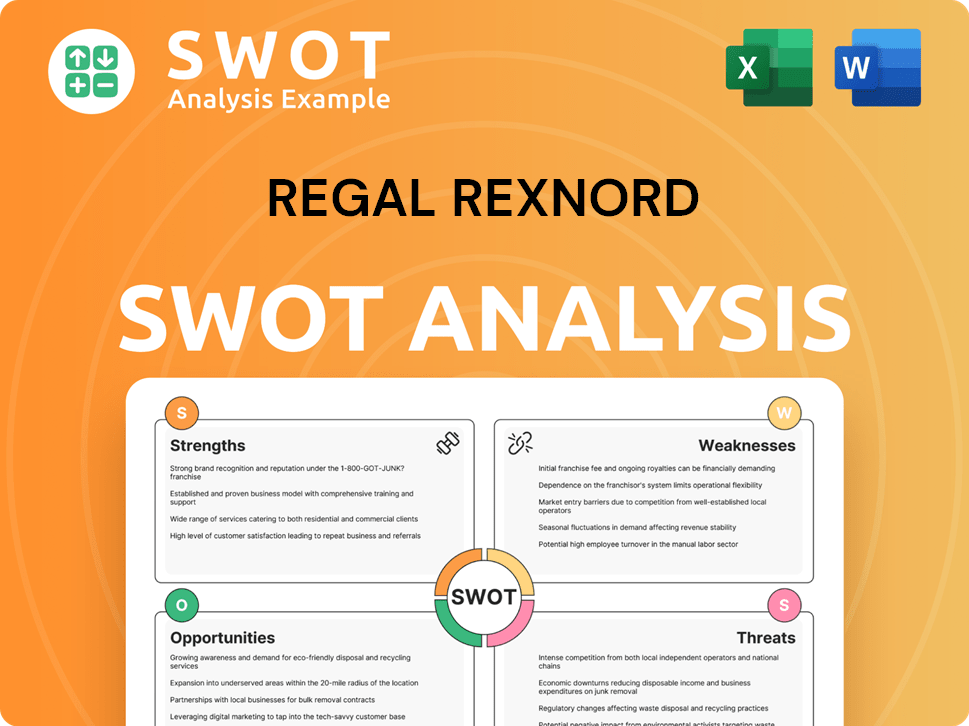
What Do Regal Rexnord’s Customers Want?
Understanding the customer needs and preferences is crucial for success. For industrial businesses, the primary focus is on efficiency, reliability, and performance. The company's customer base breakdown reveals a strong emphasis on solutions that optimize energy consumption and ensure operational excellence.
The customer demographics of the company are primarily industrial businesses, including manufacturers, processing plants, and infrastructure providers. These customers seek robust, highly-engineered products designed to withstand demanding industrial environments. The company’s target market analysis shows a strategic focus on providing long-term value and reducing downtime.
The company's customer profile is shaped by the desire for dependable operations that minimize risks and maximize output. Practical drivers include cost savings through energy efficiency and extended equipment lifespan. For example, the company's offerings in industrial powertrain solutions, such as gearboxes and gear drives, are designed to enhance machinery functionality.
Customers prioritize solutions that enhance energy efficiency and ensure maximum operational reliability. This focus drives demand for products with variable speed technology and embedded intelligence.
Customers seek robust, highly-engineered products designed to withstand demanding industrial environments. This includes solutions that offer long-term value and reduce downtime.
There is a growing emphasis on sustainability, with customers increasingly looking for solutions that optimize energy consumption and reduce environmental impact.
Customers are driven by the need for dependable operations that minimize risks and maximize output. They seek tangible benefits like cost savings through energy efficiency.
Customers are interested in solutions that integrate seamlessly into complex industrial systems. They are also looking for predictive maintenance capabilities.
Customers prioritize solutions that offer long-term value, reduced downtime, and improved productivity. This includes the extended lifespan of equipment.
The company addresses common pain points such as the need for predictive maintenance and faster operations. Feedback and market trends influence product development, leading to investments in R&D and customer-facing technologies, including AI. The company aims to double its new product vitality, particularly in secular growth markets. For instance, a strategic partnership with Honeywell for electric aircraft (eVTOL) demonstrates tailoring solutions to emerging aerospace needs. Furthermore, the company's strategic focus on the humanoid robot market secured over $20 million in annual sales for components in Q1 2025, illustrating its responsiveness to evolving customer demands. Further insights into the company's strategy can be found in the Marketing Strategy of Regal Rexnord.
The company's success hinges on understanding and meeting the specific needs of its diverse customer base. The customer demographics are primarily industrial businesses, each with unique requirements.
- Efficiency: Customers want solutions that optimize energy consumption and reduce operational costs.
- Reliability: Products must withstand demanding industrial environments and minimize downtime.
- Performance: Solutions should enhance machinery functionality and improve overall productivity.
- Sustainability: There is a growing demand for environmentally friendly and energy-efficient products.
- Innovation: Customers seek advanced technologies, including AI-driven solutions and predictive maintenance capabilities.
Regal Rexnord PESTLE Analysis
- Covers All 6 PESTLE Categories
- No Research Needed – Save Hours of Work
- Built by Experts, Trusted by Consultants
- Instant Download, Ready to Use
- 100% Editable, Fully Customizable
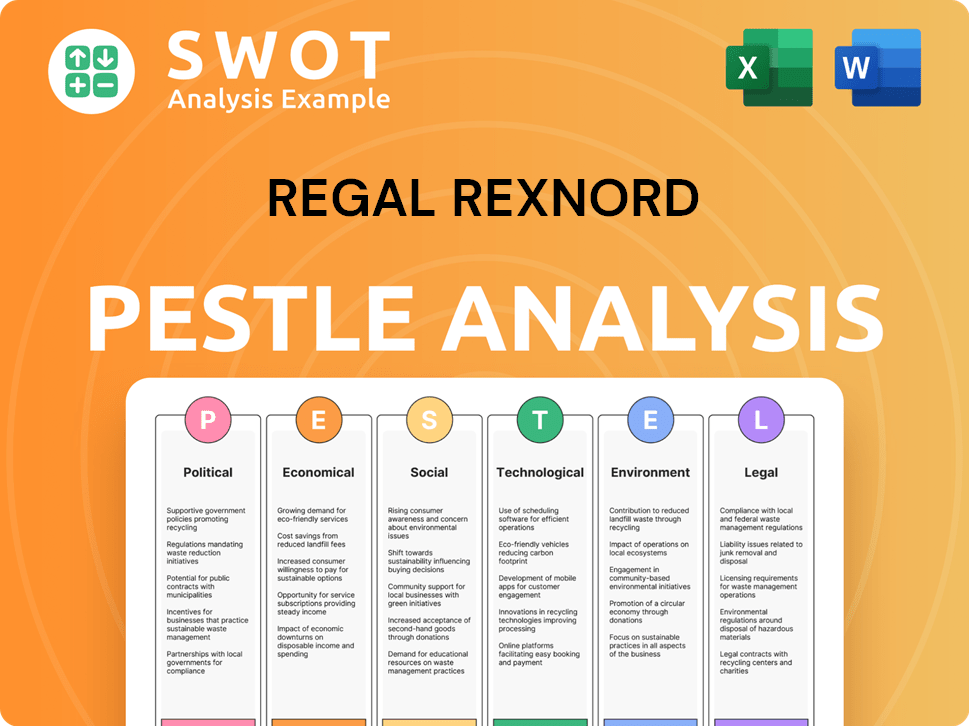
Where does Regal Rexnord operate?
The geographical market presence of the company is a critical factor in understanding its customer base and market reach. The company has established a substantial global footprint, with manufacturing, sales, and service facilities strategically located worldwide. This extensive presence allows it to efficiently serve its multinational customers and navigate the complexities of global supply chain dynamics, directly impacting its ability to meet the needs of its diverse customer demographics.
North America stands out as the largest market for the company, demonstrating its significance in the company's overall sales. The company's presence in North America is bolstered by its extensive manufacturing capabilities across the U.S. and Canada. This focus enables the company to supply high-quality products, particularly for electrical, HVAC, and industrial systems, catering to a broad range of customers within these sectors.
Beyond North America, the company maintains a robust presence in Europe, particularly in manufacturing and distribution, especially for the industrial and aerospace sectors. The company strategically tailors its products to meet the stringent regulations and standards prevalent in the European market, ensuring compliance and customer satisfaction. Furthermore, the company has a presence in Asia, though the sales figures for this region in 2024 were not as detailed as in North America, highlighting the varied market focus across different geographical segments.
In 2024, North America accounted for a significant portion of the company's sales, contributing 69.28% to the total. This underscores the region's importance to the company's overall financial performance. The strong presence in North America is supported by robust manufacturing capabilities.
Europe represents a key market for the company, especially in the industrial and aerospace sectors. The company strategically adapts its products to meet the specific regulatory standards of the European market. This ensures that the company remains competitive and compliant within the region.
The company also has a presence in Asia, although the sales figures for this region in 2024 were not as detailed. In Q1 2025, declines were observed in China, indicating a shift in market dynamics. This highlights the need for the company to adapt to regional changes.
The geographic distribution of sales in 2024 shows North America accounted for $4,179.6 million, Europe for $1,027.6 million, Asia for $552.1 million, and Rest-of-World for $274.5 million. This breakdown demonstrates the company's diversified market presence and its ability to generate revenue across various regions.
The company's global network facilitates the efficient and economical production of powertrain components, allowing for economies of scale. The company strategically localizes its offerings and marketing strategies to succeed in diverse markets, adapting to regional differences in customer demographics, preferences, and buying power. This approach is crucial for effective Growth Strategy of Regal Rexnord, ensuring that the company can meet the specific needs of its target audience in each geographical segment.
Regal Rexnord Business Model Canvas
- Complete 9-Block Business Model Canvas
- Effortlessly Communicate Your Business Strategy
- Investor-Ready BMC Format
- 100% Editable and Customizable
- Clear and Structured Layout
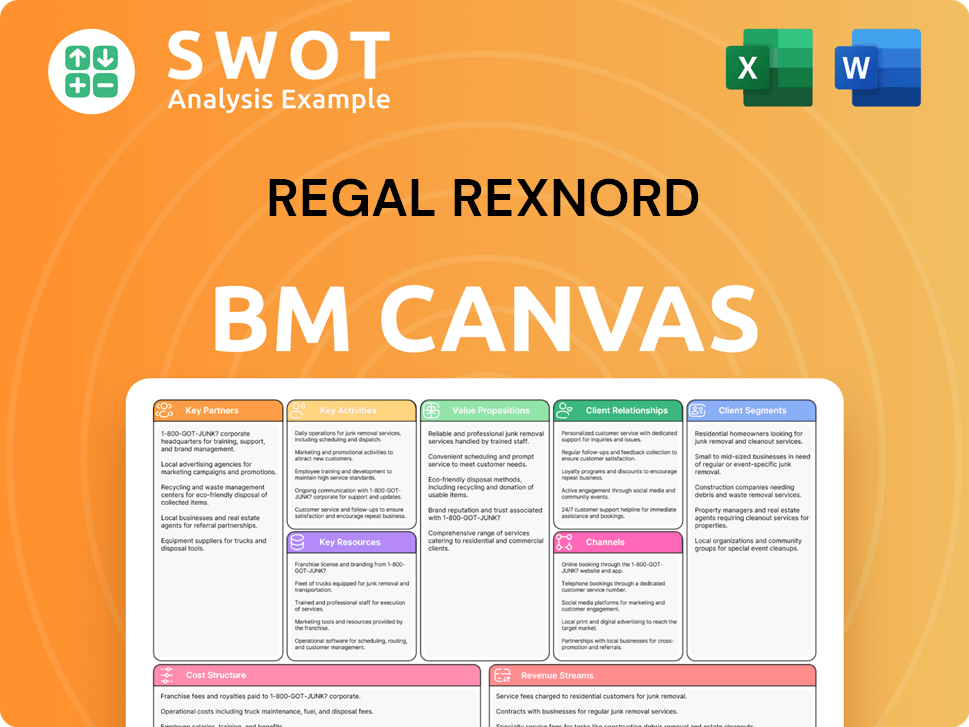
How Does Regal Rexnord Win & Keep Customers?
The company focuses on a multi-faceted approach to customer acquisition and retention, particularly within its B2B markets. They emphasize solution selling, strategic partnerships, and a robust aftermarket presence. This strategy is designed to cater to the specific needs of their target audience and maintain strong customer relationships.
Customer acquisition is driven by targeting high-growth markets, aligning with secular demand trends. Strategic investments are made in areas like factory automation, food & beverage, aerospace, medical, data centers, and alternative energy. For example, a partnership with Honeywell in Q4 2024 for the electric aircraft (eVTOL) market demonstrates a focus on emerging sectors.
Retention efforts include providing expert guidance, offering comprehensive product solutions, and ensuring efficient service through a global network. The company also leverages digital tools to enhance customer interactions. The company's focus on innovation and operational efficiency further supports customer retention by ensuring their offerings remain competitive and meet evolving needs. To learn more about the company's broader strategy, you can explore the Growth Strategy of Regal Rexnord.
The company actively targets high-growth markets like factory automation and aerospace. Strategic partnerships, like the one with Honeywell, are key. In Q1 2025, they secured over $20 million in annual sales for components in the humanoid robot market, showcasing successful entry into emerging areas.
While specific details on market segmentation are not provided, the company's focus on industries like food & beverage, aerospace, and data centers suggests a targeted approach. They align their growth investments with these identified trends and customer needs.
Expert guidance and consultation are provided to assess client needs and recommend products. Robust aftermarket sales and a global network contribute to efficient service. Innovation, with plans to double new product vitality, is a key retention strategy.
The company's focus on operational efficiency and cost management, which led to improved gross margins from 27% to 38% with a target of 40% by year-end, indirectly supports retention. This approach offers competitive value, benefiting the target audience.
The company's customer acquisition strategy focuses on high-growth markets and strategic partnerships. Retention is supported by expert guidance, efficient service, and a focus on innovation and operational efficiency.
- Strategic partnerships are crucial for entering new markets.
- Aftermarket sales and efficient service are key for customer retention.
- Innovation and operational efficiency drive long-term customer relationships.
- The company's target market includes industries like aerospace and food & beverage.
Regal Rexnord Porter's Five Forces Analysis
- Covers All 5 Competitive Forces in Detail
- Structured for Consultants, Students, and Founders
- 100% Editable in Microsoft Word & Excel
- Instant Digital Download – Use Immediately
- Compatible with Mac & PC – Fully Unlocked
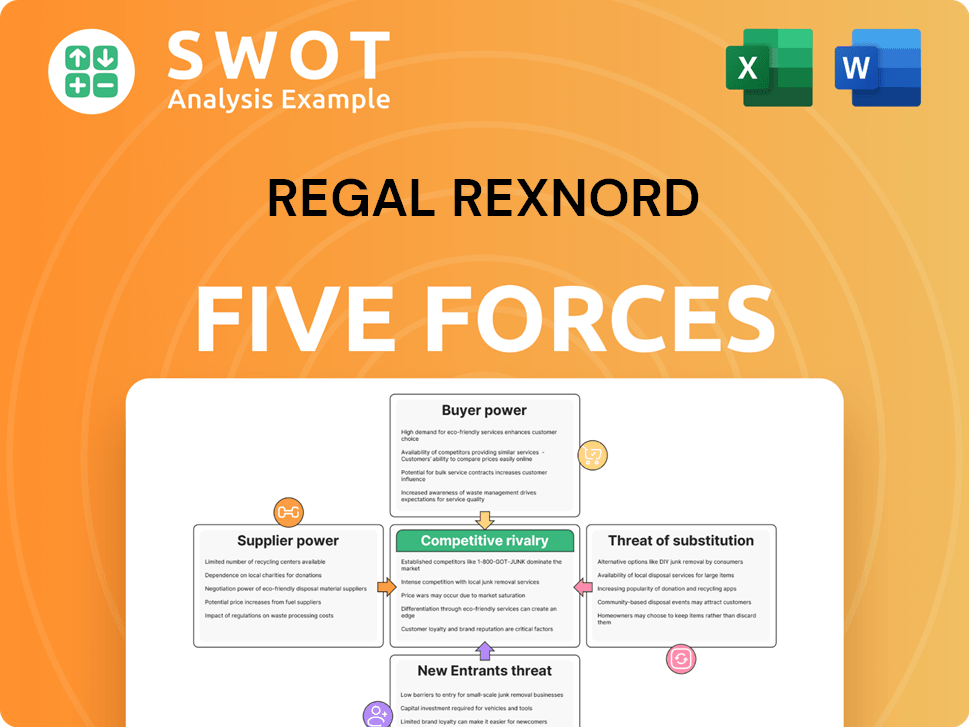
Related Blogs
- What are Mission Vision & Core Values of Regal Rexnord Company?
- What is Competitive Landscape of Regal Rexnord Company?
- What is Growth Strategy and Future Prospects of Regal Rexnord Company?
- How Does Regal Rexnord Company Work?
- What is Sales and Marketing Strategy of Regal Rexnord Company?
- What is Brief History of Regal Rexnord Company?
- Who Owns Regal Rexnord Company?
Disclaimer
All information, articles, and product details provided on this website are for general informational and educational purposes only. We do not claim any ownership over, nor do we intend to infringe upon, any trademarks, copyrights, logos, brand names, or other intellectual property mentioned or depicted on this site. Such intellectual property remains the property of its respective owners, and any references here are made solely for identification or informational purposes, without implying any affiliation, endorsement, or partnership.
We make no representations or warranties, express or implied, regarding the accuracy, completeness, or suitability of any content or products presented. Nothing on this website should be construed as legal, tax, investment, financial, medical, or other professional advice. In addition, no part of this site—including articles or product references—constitutes a solicitation, recommendation, endorsement, advertisement, or offer to buy or sell any securities, franchises, or other financial instruments, particularly in jurisdictions where such activity would be unlawful.
All content is of a general nature and may not address the specific circumstances of any individual or entity. It is not a substitute for professional advice or services. Any actions you take based on the information provided here are strictly at your own risk. You accept full responsibility for any decisions or outcomes arising from your use of this website and agree to release us from any liability in connection with your use of, or reliance upon, the content or products found herein.